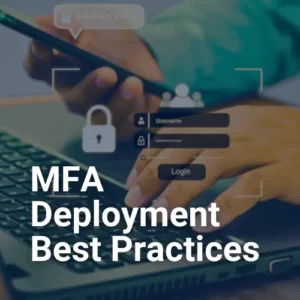What is it?
Multi-factor Authentication (MFA) is the process of verifying that you are who you claim to be when logging in to a device or an account. If you’re reading this from your work computer, you probably logged in to your computer – that’s single-factor authentication. But single-factor authentication is no longer enough to keep your accounts secure. Learn more below about the various ways you can digitally authenticate your identity.
Understanding the Types of Identity Claim Factors:
- Something you own. This is using a mobile phone or device that you have in your possession to prove your identity. Typically, the device provides a code via an application, text message, email, or voice call. You then enter this code, and for successful authentication, your code must match what is expected by the service you’re attempting to log in to.
- Something you know. This is something you’ve memorized or stored somewhere, such as a PIN. You must supply the correct PIN to log in to your device or service.
- Something you are. This factor is something about your physical body that cannot be altered, such as your fingerprint or retina. Biometric scanners or readers are used to confirm you’re physically the person that you’re claiming to be.
Why do I need it?
In our digitally-driven world, passwords are no longer enough to keep your information safe. These days, it takes minimal effort for hackers to break into, or social engineer their way into, accounts that are only protected by passwords. Adding an extra step to access your accounts, such as entering an authentication code, means that hackers would also need to have your phone to break in.
Create an additional layer of security and make it harder for criminals to access your data by using two-factor or multi-factor authentication. Consult your IT or Security department to see if your organization has a preferred method of multi-factor authentication.
The KnowBe4 Security Team
KnowBe4.com


